|
 |
 |
Pest
Management

Source: USDA - National Resources Conservation Service
|
Pesticides are used to control pests, which include insects, mice and other
animals, unwanted plants (weeds), fungi, or microorganisms like bacteria
and viruses. Though often misunderstood to refer only to insecticides, the
term pesticide also applies to herbicides (that control weeds), fungicides
(that control fungi), and substances used to control other pests.
Today, pesticides are used on the vast majority of U.S. cropland. According
to agricultural chemical usage statistics from USDA, herbicides were applied
to 98% of corn acreage and 96% of soybean acreage in 2001.
Operations and Timing
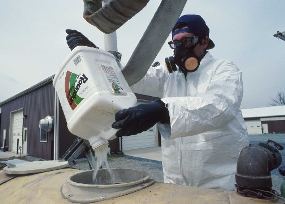
Source: USDA - National Resources Conservation Service
|
Pesticides are either applied prior to planting ("preplant"),
before the crop emerges ("preemergence")
or after the plant has emerged ("postemergence").
The label includes information on when the product should be applied.
Labels often list the minimum number of days which must pass between the
last pesticide application and harvest of crops or grazing by livestock.
These are intervals set by EPA to allow time for the pesticide to break
down in the environment, preventing residues on food, feed, or animal
products.
Back to Top
Application Practices
More and more producers have their pesticides applied by commercial applicators.
This practice has many advantages, such as not having to store pesticides
on-farm, avoiding having to be certified as pest control applicators,
and benefiting from the dealer's record keeping.
| 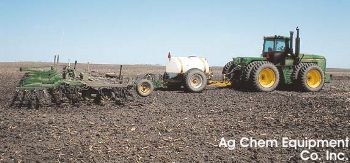
|
A tractor-sprayer-field cultivator combo
that performs
tillage and crop chemical application operations
simultaneously. |
| (Source: ag-chem, a division of AGCO
Corporation.) |
Sprayers - are implements or vehicles used to apply liquid
crop chemicals, most often herbicides, and increasingly, fertilizers. Sprayers
typically include a tank, pump, plumbing, valves, a boom, and nozzles. Sprayers
can be mounted on a tractor or other implement, pulled by a tractor, self-propelled,
or mounted on airplanes or helicopters. Large self-propelled sprayers that
incorporate technologies to vary application rates within a field can cost
more than $250,000.
| A pull-type sprayer and tractor. |
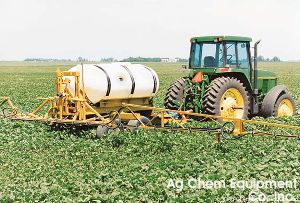
(Source: ag-chem, a division of AGCO Corporation.)
|
| A self-propelled sprayer broadcasting
crop chemicals in the field. |
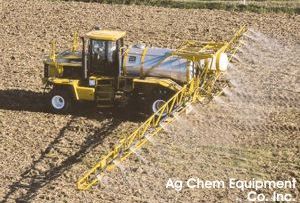
(Source: ag-chem, a division of AGCO Corporation.)
|
- Aerial Application
Aerial application of pesticides has several advantages for the modern
agricultural producer. When properly managed, aerial application offers
speed of dispersal, accessibility to crops on areas where ground equipment
cannot operate, and reasonable cost. In many cases, aerial application
also allows more timely applications and, therefore, better utilization
of pesticides.
Aerial application programs require good cooperation between the
pilot and grower. It must also recognize the potential dangers to
people, other crops and the environment.
Limitations on aerial application include weather hazards, fixed
obstacles such as radius towers, field size and shape, the distance
from the point of application to the landing area, and the danger
of contamination of nearby areas due to drift or misapplication. Careless
applications can be harmful to the crop, the grower and the applicator.
Source: University
of Kentucky - Applicator Training Manual for Aerial Application of
Pesticides 
- Chemigation
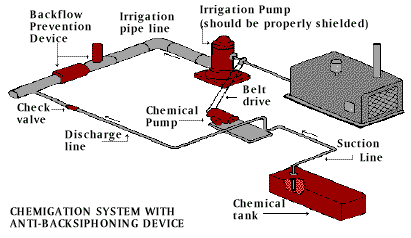
A growing practice in many areas of the country is the application
of pesticides through irrigation systems, often termed "chemigation."
Although there are systems specifically designed for chemigation,
in most cases an existing irrigation system is modified to mix the
chemical with irrigation water. Fertilizers are generally stored in
large tanks located near wells drawing ground water for irrigation.
Fertilizers flow from the storage tanks into the irrigation water.
Concerns about groundwater contamination from this practice arise
from the fact that accidental backflow or siphoning of chemicals into
the well can occur when the irrigation pumping system shuts down unexpectedly.
Source: EPA
- Software for Environmental Awareness, Chemigation 
Back to Top
Potential Environmental Concerns
The likelihood of pesticide contamination of groundwater and water wells
depends partly on the geologic and hydrologic characteristics that vary
from location to location as well as on pesticide characteristics.
Contamination of drinking water wells by pesticides is usually the result
of one or more of the following:
- Improper application of pesticides on the fields
- Careless handling of the pesticides
- Careless storage of pesticides
- Careless disposal of unused pesticides and pesticide containers.
Ideally, pesticides should be applied at just the right time to control
pests, then degrade into harmless compounds in the soil, air, or water
without contaminating the environment. However, this is difficult to attain.
Pesticides have the potential to harm the environment by injuring nontarget
plants and animals, leaving harmful residues, or moving from the application
site into the surrounding environment.
Some pesticides (called accumulative pesticides) can build up in the
bodies of animals over time, including humans. These persistent pesticides
stay in the environment without change for long periods of time. Pesticides
which break down quickly in the environment to form harmless materials
area called non-persistent. Most agricultural pesticides used in the U.S.
are broken down easily by microorganisms or sunlight.
Pesticides come into contact with nontarget insects and plants through
drift, runoff, or spills. Drift to nearby areas may injure fish, birds,
other wildlife, and sensitive plants. It can also damage nearby crops,
forests, or landscape plantings. Poorly timed applications can kill bees
and other pollinators which are working in the area, or beneficial parasites
and predators that help control pests naturally .
Pesticides have the potential to contaminate both surface waters (lakes,
streams, ponds, rivers) and ground water.
Pesticides can move into surface water through surface runoff,
attached to eroding soil particles, or from tile drainage systems. Concerns
about pesticide movement in surface runoff include pesticide persistence,
time between application and a runoff event, and any management practices
in place that reduce surface runoff from the field.
Pesticides can also leach into ground water. The soil
type plays an important role in determining the extent to which pesticides
leach to ground water. Sandy soils greatly increase the risk of pesticide
loss, because they have very limited capacities to adsorb pesticides.
In karst areas, pesticides can easily
reach ground water through sinkholes. Pesticides may also enter ground
water via improperly constructed wells or by back-siphoning into wells
while mixing and filling the applicator chemicals. Cases of ground water
contamination have also been traced to spills and improper handling of
pesticides (such as improper disposal of excess spray and rinsate from
cleaning equipment).
The EPA has labeled some commonly used pesticides as having a high probability
of moving into ground water when applied to very porous soils. Some pesticides
are required to have a statement on their label such as "This product
is a chemical that can travel through the soil and contaminate ground
water, which may be used as drinking water. This product has been found
in ground water because of agricultural use. Users are advised not to
apply this product where the water table is close to the surface or where
soils are very permeable. Your local Cooperative Extension Service Office
can provide further information on the type of soil in your area and the
location of ground water".
Back to Top
Best Management Practices
- Integrated pest management (IPM): IPM programs use
a range of methods and disciplines to assure stable and economical crop
production while minimizing risks to humans, animals, plants and the
environment. IPM weighs costs, benefits, and impacts on health and the
environment and thus identifies the most suitable ways to control pests.
Options include prevention, monitoring, mechanical trapping devices,
natural predators, biological pesticides, and, if appropriate, chemical
pesticides.
- Pesticide selection: Select a pesticide that will
have the least impact on the environment. Environmental impacts of pesticides
depend on sorption (how tightly pesticide is held by the soil surfaces),
water solubility (the amount of pesticide that will dissolve in a given
amount of water), and persistence (the amount of time a pesticide remains
in the environment. Pesticides with high sorption and low solubility
are much less likely to leach into groundwater, or be transported by
runoff. Pesticides with low persistence (short half-life) are likely
to break down into less harmful compounds before they have a chance
to harm the environment.
- Timing: Apply pesticides only when they are needed
for pest control, and when conditions are least likely for the pesticide
to move to ground or surface water. Contamination events often happen
when pesticides are applied just before a high-intensity rainfall, when
runoff can move the newly-applied pesticide into lakes and streams.
The window of highest vulnerability for pesticide runoff is typically
within 10 to 15 days after application.
|
- Sprayer calibration: Apply the correct amount,
which can only be done if sprayers are calibrated regularly.
|
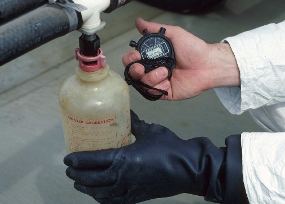
Source: USDA - National Resources Conservation Service
|
Spray nozzles are an important part of pesticide application equipment.
Quality nozzles can reduce pesticide use and reduce environmental pollution.
In row crops, nozzle patterns are
directed downward. In citrus and other tree crop applications, it is a
common practice to direct half the spray volume laterally toward the upper
half of the tree and the rest to the lower half.
Sprayer calibration: Application errors can originate
from either incorrect pesticide concentration in the tank, (mixing error)
or incorrect sprayer output per unit area (calibration error). The latter
may be due to travel speed, nozzle pressure, or the use of improper, defective
and worn nozzles. By properly matching sprayer discharge rate, swath width
and travel speed, calibration errors can be minimized. Sprayer calibration
can be carried out by:
a) determining the amount of the tank mix used to spray a known area;
b) operating the sprayer in a fixed place and measuring the amount
of discharged liquid (water) for a specified time;
or c) collecting the nozzle discharge and determining the output for
a time period.
The use of high capacity nozzles at low pressures to achieve low-volume
application rates, one-sided calibration of the sprayer for two-sided
operations and vice versa, calibration at closed pressure settings and
intermittent operation of the nozzles can introduce errors in application
rates. Sprayers using positive displacement pumps (diaphragm, piston,
etc.) have more potential for application error compared to sprayers using
centrifugal pumps, particularly at high volume rates.
Source: Florida Cooperative
Extension Service/Institute of Food and Agricultural Sciences/University
of Florida 
- Consider alternatives: Alternatives to chemical
pesticides include:
- Biological pesticides, which target specific pests. Because
of this targeting, these methods are generally considered to pose
less risk to human beings, other species and the environment.
- Microbial pesticides, which are naturally occurring or genetically
altered microorganisms including fungi, viruses, and bacteria.
- Pheromones, which disrupt normal mating behavior by stimulating
breeding pests and luring them into traps.
- Cultural practices such as different tillage practices and not
growing the same crop every year (crop rotation).
|
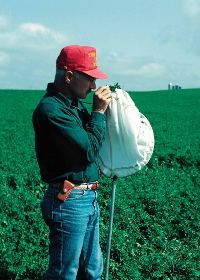
Source: USDA - National Resources Conservation Service
|
- Avoid sensitive areas: Know the location of sensitive
areas such as sinkholes, depressions,
wells, surface water, public institutions. For example, buffer zone
should be in effect when applying pesticides around these sites. A buffer
is required between the application of atrazine, one
of the most common herbicides, and wells or surface water.
Back to Top
 Back
to Crop Production Menu Back
to Crop Production Menu
|

